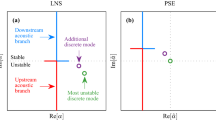Abstract
The phenomenon of laminar-turbulent transition exists universally in nature and various engineering practice. The prediction of transition position is one of crucial theories and practical problems in fluid mechanics due to the different characteristics of laminar flow and turbulent flow. Two types of disturbances are imposed at the entrance, i.e., identical amplitude and wavepacket disturbances, along the spanwise direction in the incompressible boundary layers. The disturbances of identical amplitude are consisted of one two-dimensional (2D) wave and two three-dimensional (3D) waves. The parabolized stability equation (PSE) is used to research the evolution of disturbances and to predict the transition position. The results are compared with those obtained by the numerical simulation. The results show that the PSE method can investigate the evolution of disturbances and predict the transition position. At the same time, the calculation speed is much faster than that of the numerical simulation.
Similar content being viewed by others
References
Herbert, T. H. Boundary-layer transition-analysis and prediction revisited. AIAA Paper 91-737 (1991)
Herbert, T. H. Parabolized stability equation. Annual Review of Fluid Mechanics, 29(1), 245–283 (1997)
Bertolotti, F. P. and Herbert, T. H. Analysis of linear stability of compressible boundary layers using the PSE. Theoretical and Computational Fluid Dynamics, 3(2), 117–124 (1991)
Chang, C. L., Malik, M. R., Erlebacher, G., and Hussaini, M. Y. Compressible stability of growing boundary layer using parabolized stability equations. AIAA Paper 91-1636 (1991)
Bertolotti, F. P., Herbert, T. H., and Spalart, P. R. Linear and nonlinear stability of the Blasius boundary layer. Journal of Fluid Mechanics, 242(1), 441–474 (1992)
Joslin, R. D., Chang, C. L., and Streett, C. L. Spatial direct numerical simulation of boundarylayer transition mechanisms: validation of PSE theory. Theoretical and Computational Fluid Dynamics, 4(6), 271–288 (1993)
Esfanhanian, V., Hejranfar, K., and Sabetghadam, F. Linear and nonlinear PSE for stability analysis of the Blasius boundary layer using compact scheme. Journal of Fluids Engineering, 123(3), 545–550 (2001)
Zhang, Y. M. and Zhou, H. Verification of the parabolized stability equations for its application to compressible boundary layers. Applied Mathematics and Mechanics (English Edition), 28(8), 987–998 (2007) DOI 10.1007/s10483-007-0801-3
Malik, M. R., Chuang, S., and Hussaini, M. Y. Accurate numerical solution of compressible, linear stability equation. Journal of Applied Mathematics and Physics (ZAMP), 33(2), 189–201 (1982)
Author information
Authors and Affiliations
Corresponding author
Additional information
Project supported by the National Basic Research Program of China (No. 2009CB724103)
Rights and permissions
About this article
Cite this article
Li, J., Luo, Js. Applications of parabolized stability equation for predicting transition position in boundary layers. Appl. Math. Mech.-Engl. Ed. 33, 679–686 (2012). https://doi.org/10.1007/s10483-012-1579-7
Received:
Revised:
Published:
Issue Date:
DOI: https://doi.org/10.1007/s10483-012-1579-7
Key words
- transition position
- incompressible boundary layer
- parabolized stability equation (PSE)
- numerical simulation



